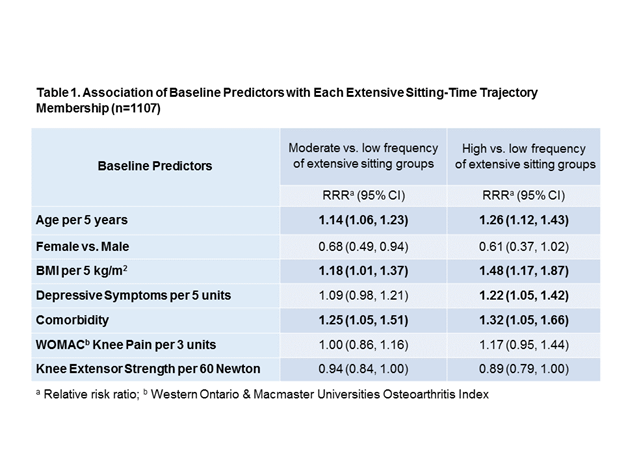Session Information
Date: Monday, October 22, 2018
Session Type: ACR Poster Session B
Session Time: 9:00AM-11:00AM
Background/Purpose: Too much sitting has been recognized as a major public health issue. However, it is unknown if distinctive patterns of extensive sitting over time exists among unique groups of persons at high risk for osteoarthritis (OA) or if sitting behavior changes over time. The purpose of this study was to examine whether there are distinct extensive sitting trajectories over up to 8 years of follow-up, then to identify baseline demographic or clinical predictors for membership in specific sitting trajectories.
Methods: Prospective cohort data from 1194 OAI participants without OA in either knee (bilateral KL 0 on baseline x-rays) were collected at 4 US sites through 8 years of follow-up. Extensive sitting was defined as a self-report of 5 or more days of sitting activities over the past week and more than 4 hours per day during those days using PASE sitting items. Latent mixture modeling was used to identify trajectories in extensive sitting (yes vs. no) over time. Baseline demographic and clinical predictors were examined using multinomial logistic regression to identify predictors for membership in extensive sitting trajectories.
Results: Three distinct extensive sitting trajectories were identified from the 1194 participants (mean age 58.4 years [SD 8.9], 58.4% female, mean BMI 26.8 kg/m2 [SD 4.5]): low frequency of extensive sitting (54%), moderate frequency of extensive sitting (36%), and high frequency of extensive sitting (10%) (Figure 1). All trajectories were fairly stable over time. Compared to the low-frequency of extensive sitting group, persons in high-frequency were significantly more likely to be older(relative risk ratio [RRR]=1.26 per 5 years increase; 95% confidence interval (CI)=1.12, 1.43), have higher BMI (RRR=1.48 per 5 kg/m2 increase; 95% CI=1.17, 1.87), report higher depressive symptoms (RRR=1.22; 95% CI=1.05, 1.42), and more comorbidities (RRR=1.32, 95% CI=1.05, 1.66 per 3 unit increase) after adjusting for confounders (Table 1); persons in moderate-frequency of extensive sitting had similar findings, but depressive symptoms was not statistically significant (RRR=1.09 per 3 unit increase, 95% CI=0.98, 1.21).
Conclusion: We identified three distinct extensive sitting trajectories among persons at high risk of knee OA. Baseline factors including depressive symptoms and comorbidity independently predicted trajectory membership in high vs. low frequency of extensive sitting. These factors could be considered in future interventions to reduce extensive sitting in persons at high risk of knee OA.
To cite this abstract in AMA style:
Lee J, Chang AH, Almagor O, Chmiel JS, Hayes KW, Kwoh CK, Sharma L. Trajectories of Extensive Sitting and Associated Predictors in Persons at High Risk for Knee Osteoarthritis [abstract]. Arthritis Rheumatol. 2018; 70 (suppl 9). https://acrabstracts.org/abstract/trajectories-of-extensive-sitting-and-associated-predictors-in-persons-at-high-risk-for-knee-osteoarthritis/. Accessed .« Back to 2018 ACR/ARHP Annual Meeting
ACR Meeting Abstracts - https://acrabstracts.org/abstract/trajectories-of-extensive-sitting-and-associated-predictors-in-persons-at-high-risk-for-knee-osteoarthritis/


